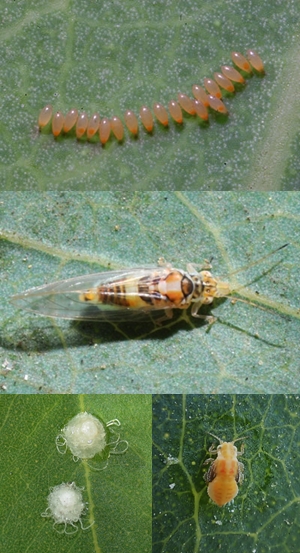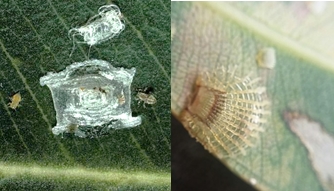PESTS AND DISEASES OF FORESTRY IN NEW ZEALAND
New eucalypt feeding insect established in New Zealand
Scion is the leading provider of forest-related knowledge in New Zealand
Formerly known as the Forest Research Institute, Scion has been a leader in research relating to forest health for over 50 years. The Rotorua-based Crown Research Institute continues to provide science that will protect all forests from damage caused by insect pests, pathogens and weeds. The information presented below arises from these research activities.
From Forest Health News 277, November 2017.
The red gum lerp psyllid, Glycaspis brimblecombei is now established in New Zealand. The psyllid was originally detected on 5-year-old Eucalyptus camaldulensis in northern Canterbury in early winter 2017. A well-established population appeared to be present and MPI has now stood down its response, opting not to eradicate in this instance.
This psyllid is native to Australia and has invaded eucalypt growing regions around the world, including North and South America, Africa, and Europe. Its hosts are in the Symphyomyrtus sub-genus (favourite food for most euc pests here). The preferred host species is probably E. camaldulensis, while other notable, but less susceptible, hosts are the adult leaf forms of E. nitens and E. globulus.

Credit: INaturalist users’ psyllidhipster, quantron, and the EPPO.
Red gum lerp adults are efficient dispersers and known overseas to spread rapidly once established. Numbers can rapidly increase, with females recorded laying up to 700 eggs in total in clusters of 50-75. This pest uses its piercing mouth parts to suck sap from its host tree, thereby damaging the host. The juveniles (nymphs) also secrete a distinctive waxy protective cover over themselves, called a lerp. It is unknown how many generations a year this psyllid will complete, but anywhere from two to four is likely based on overseas data.
The most common damage from this pest is leaf discoloration. However, in heavy infestations, severe leaf drop and twig dieback can occur. In California, the severe infestations of this psyllid facilitate the attack of secondary pests, such as long horn beetles (e.g., Phoracantha spp.), and without proper management, severe, repeated attacks can result in tree death. Other nuisance impacts may come from the honeydew the psyllid secretes and the associated sooty mould that grows on it, as well as wasps attracted to the honeydew.
Eucalypts in New Zealand are already hosts to numerous sap sucking psyllids, including the closely related species Glycaspis granulata.
Glycaspis granulata is attacked by the self-introduced parasitoid Psyllaephagus bliteus. This very same parasitoid has been introduced into multiple countries to control G. brimblecombei with variable success. Lab experiments overseas have shown this parasitoid can attack and complete development on all juvenile life stages. We consider there is a high likelihood that this parasitoid will be effective here against both hosts. Generalist predators such as ladybirds and spiders are also likely to feed on this psyllid but are unlikely to have a significant impact on pest numbers.
The lerp of G. brimblecombei is superficially very similar to G. granulata in the field, but can be readily distinguished from that of another psyllid Cardiaspina fiscella.

Credit: Scion & NatureWatch NZ user jefffryett
Adult G. brimblecombei are described by CABI as “approximately 4-5 mm in length from the head to the wing tips. They are yellow or light green in colour with contrasting dark eyes, and occasional dark-brown markings”.
The size of the juveniles depends on their age, but will be up to 2 mm in length if you remove their protective lerp. “The body colour is yellowish orange, with dark-brown coloration on the wing pads, legs, antennae, last abdominal segments, and in blotches on the dorsal areas of the head and thorax. The wing pads and other parts of the body have bright white spots associated with setal (eds. setal is a hair or bristle) positions“. The eggs “are laid randomly on the leaves or in clusters of 50-75 eggs, usually at an angle or perpendicular to the plant surface. They are spindle-shaped, yellow or cream coloured, and are slightly less than 1 mm in length”.
Andrew Pugh, Toni Withers, & Stephanie Sopow
Red gum lerp psyllid addendum
From Forest Health News 278, January 2018.
In our last edition we introduced the new, to New Zealand red gum lerp psyllid, Glycaspis brimblecombei. We were remiss to not acknowledge the excellent work of Paul Bradbury (SPS Biosecurity) in recognising it as likely a different species in the field. The dedicated staff at SPS do an excellent job at recognising new organisms in New Zealand.
Andrew Pugh (Scion)
This information is intended for general interest only. It is not intended to be a substitute for specific specialist advice on any matter and should not be relied on for that purpose. Scion will not be liable for any direct, indirect, incidental, special, consequential or exemplary damages, loss of profits, or any other intangible losses that result from using the information provided on this site.
(Scion is the trading name of the New Zealand Forest Research Institute Limited.)



